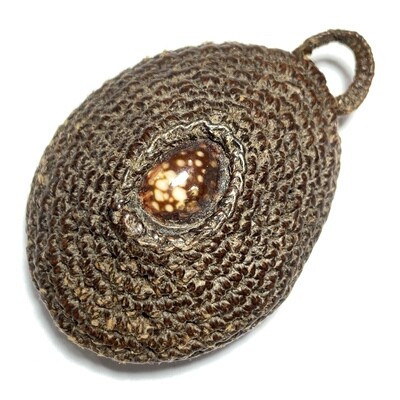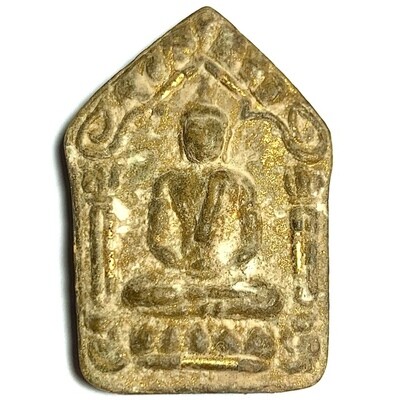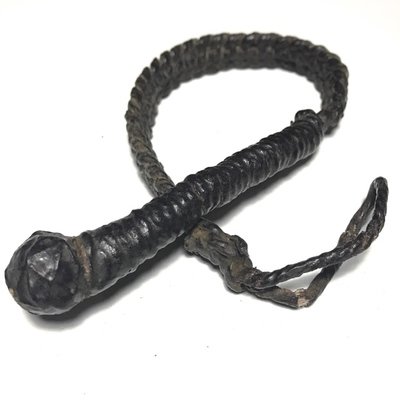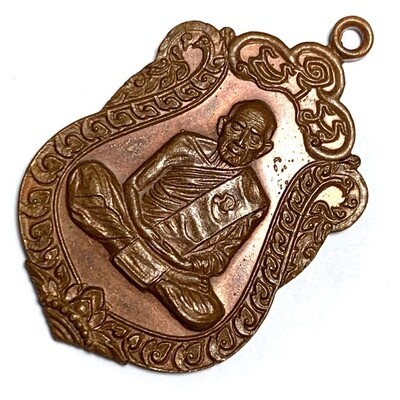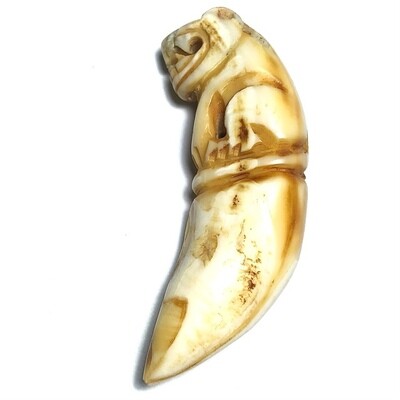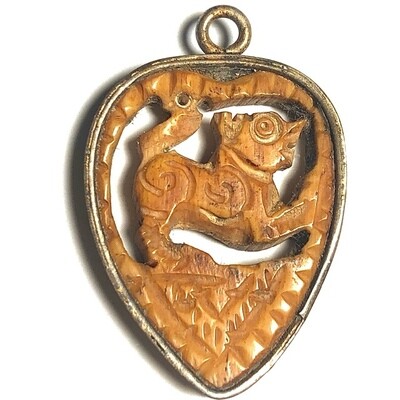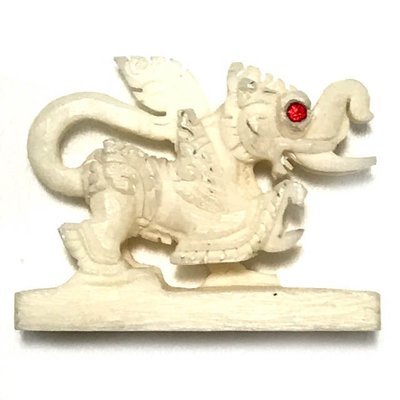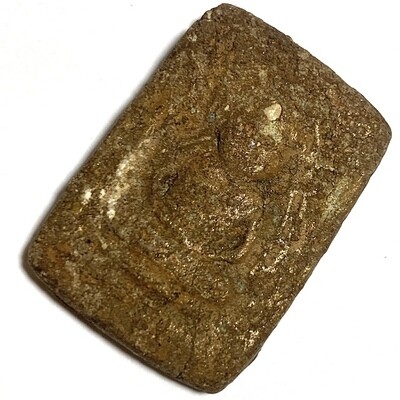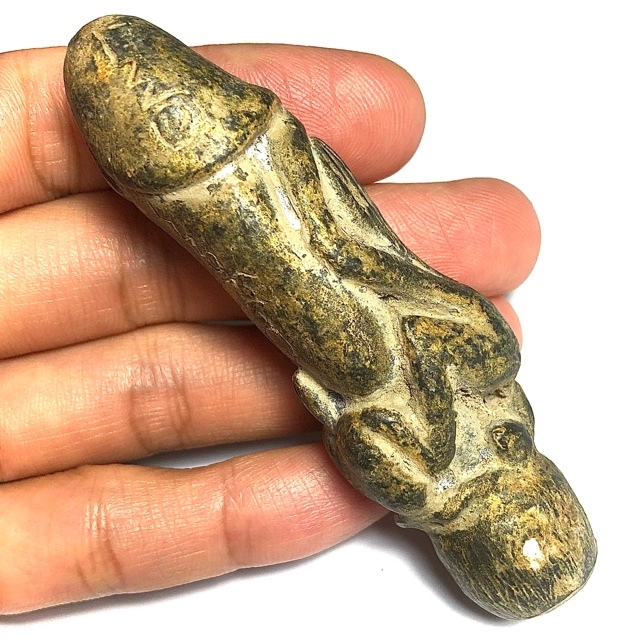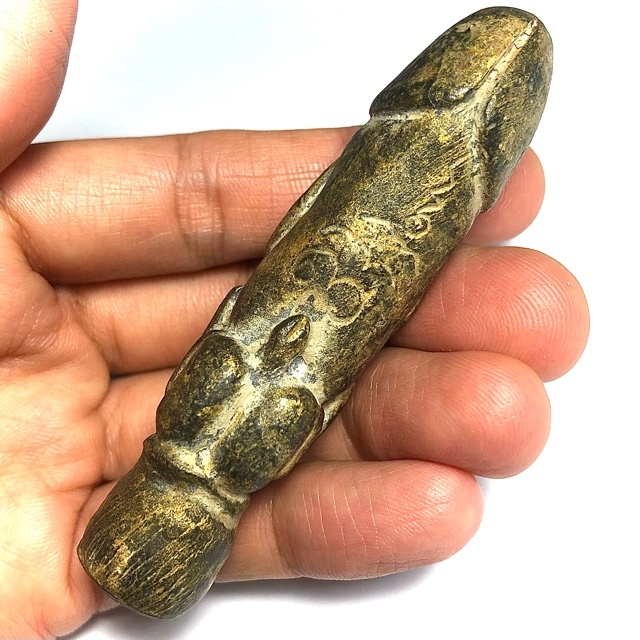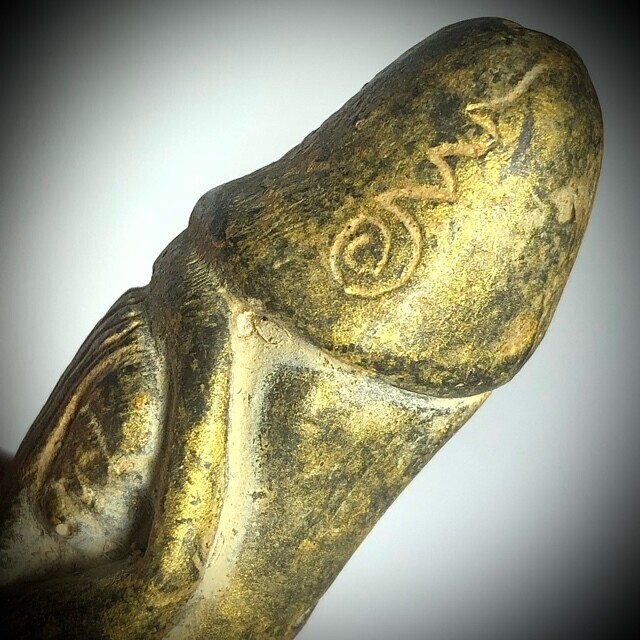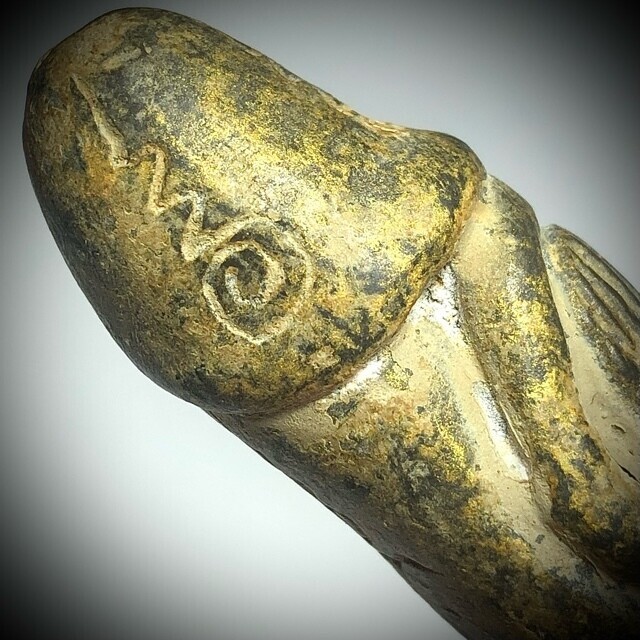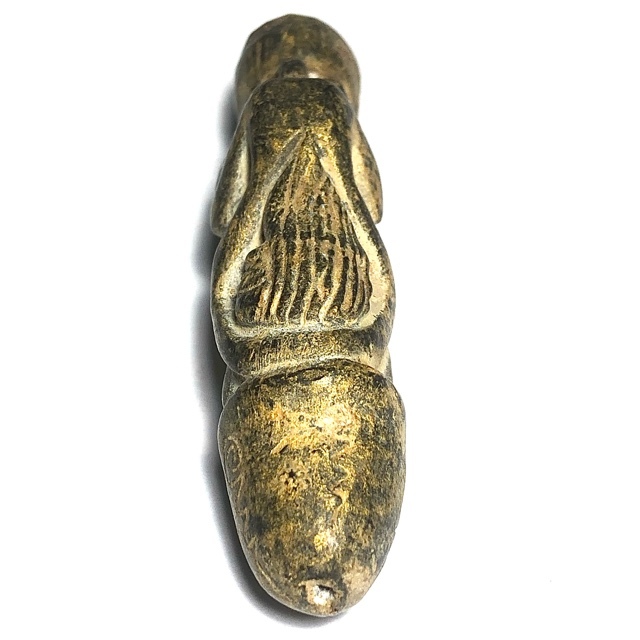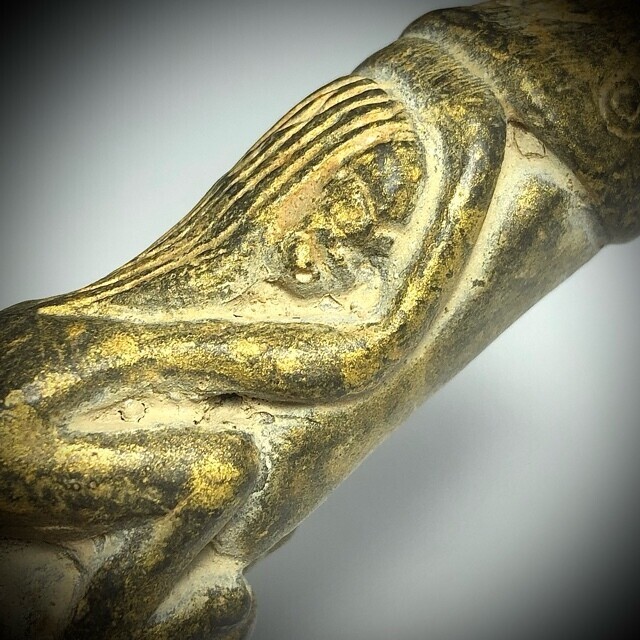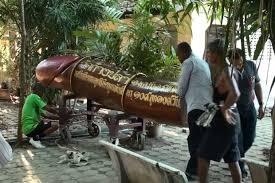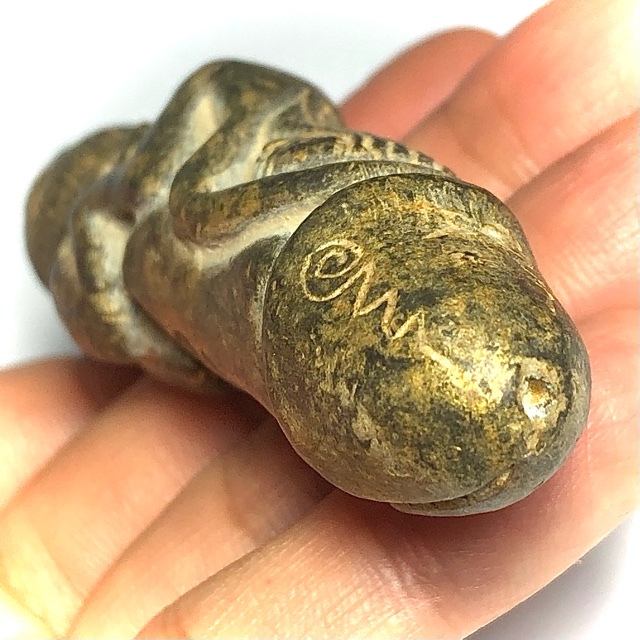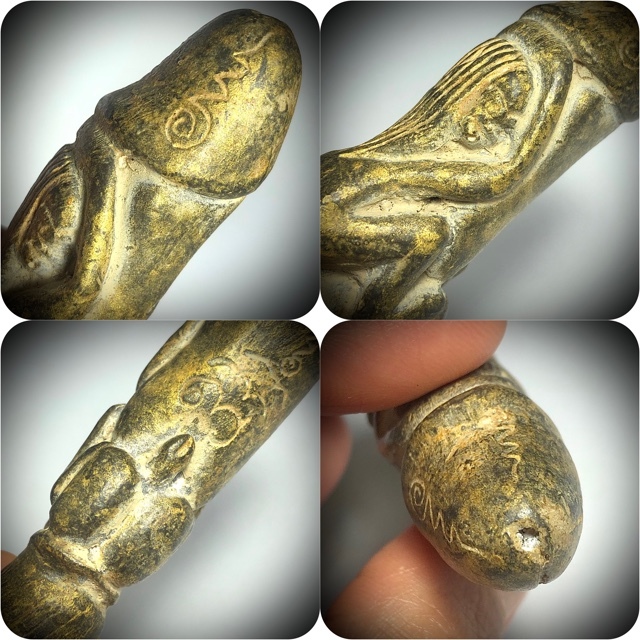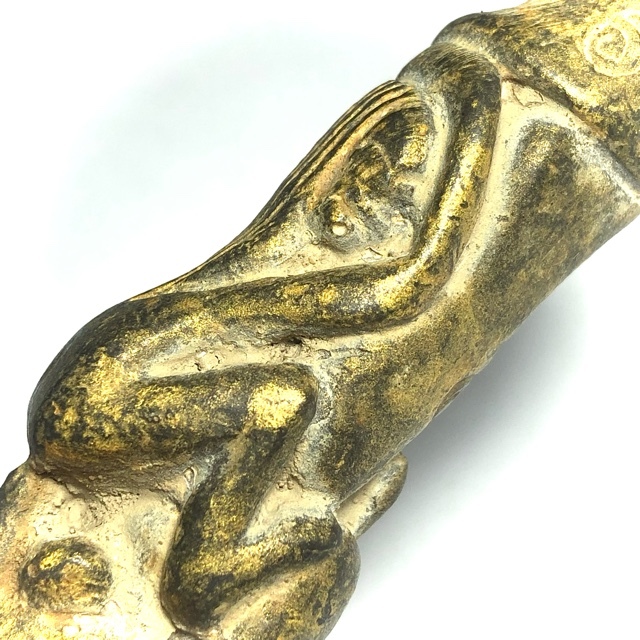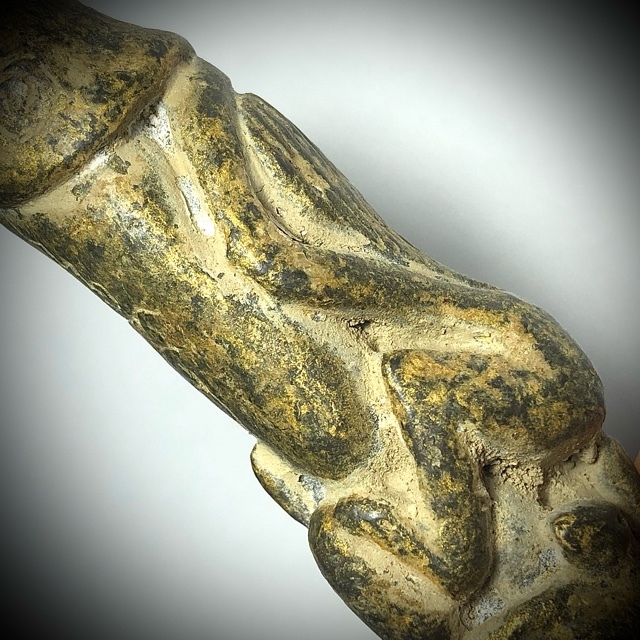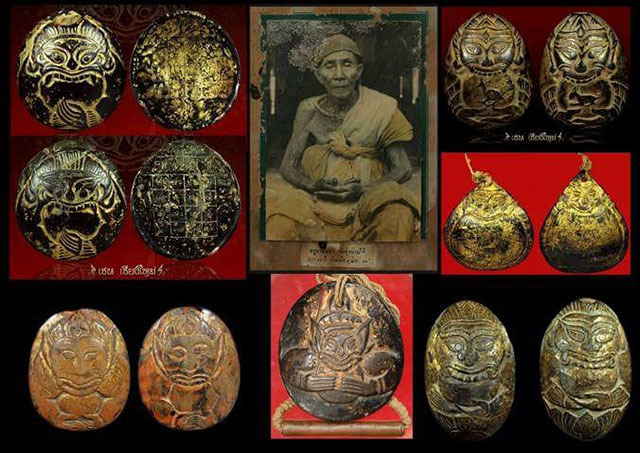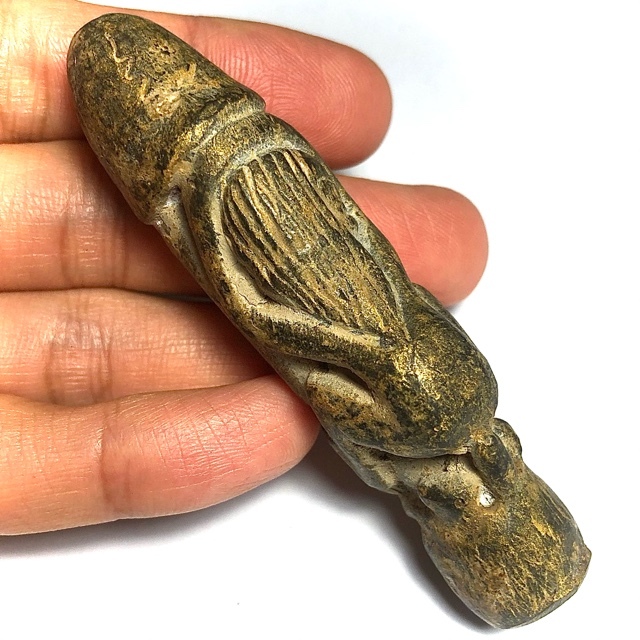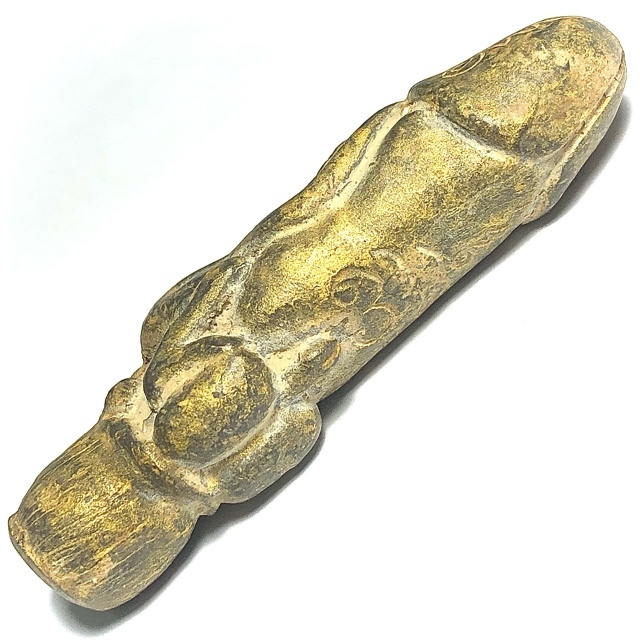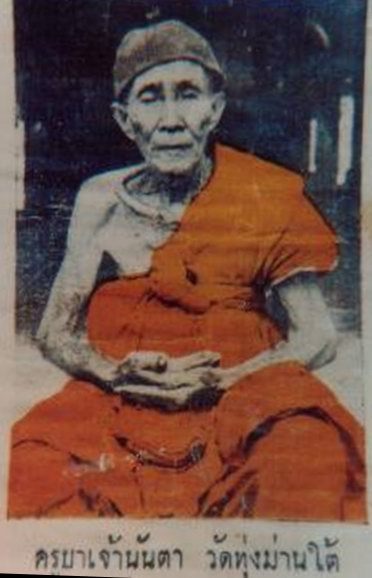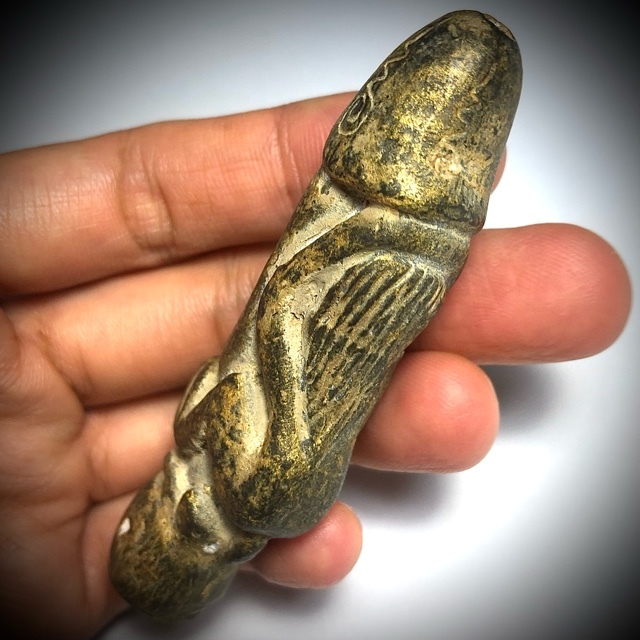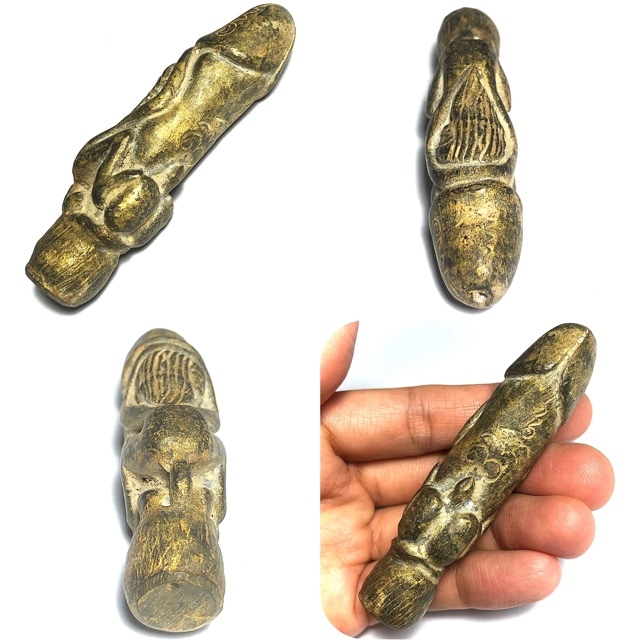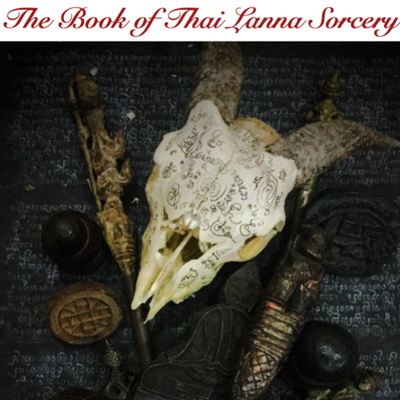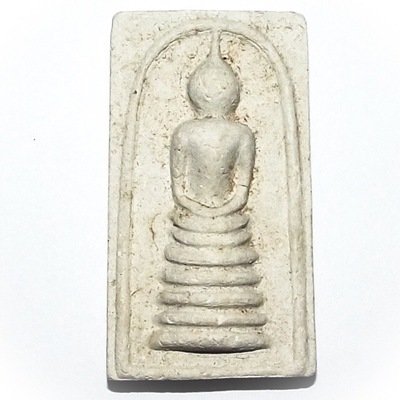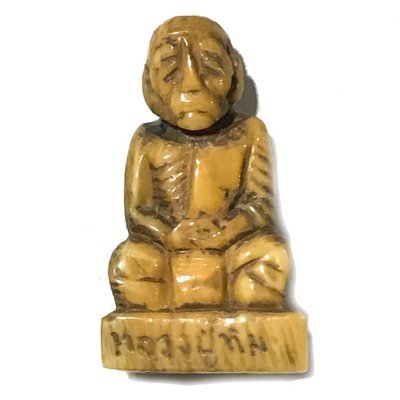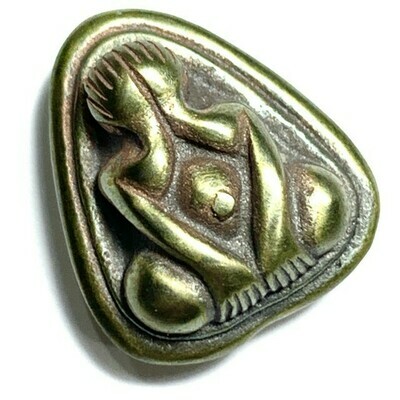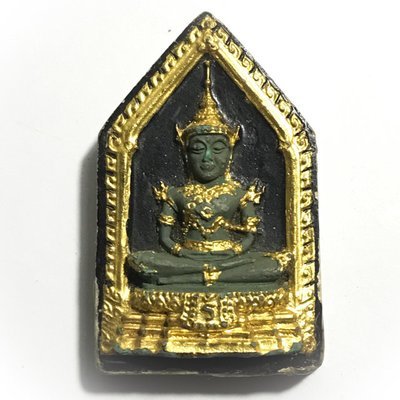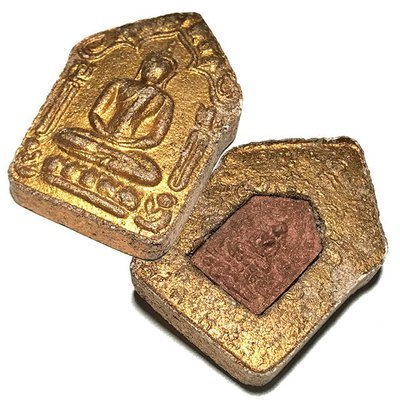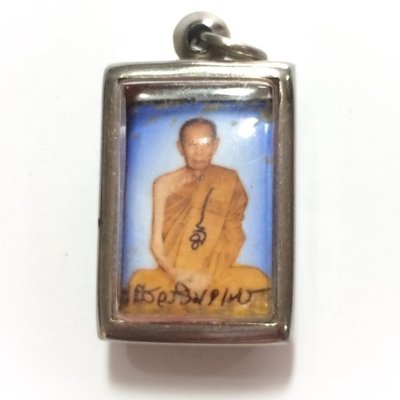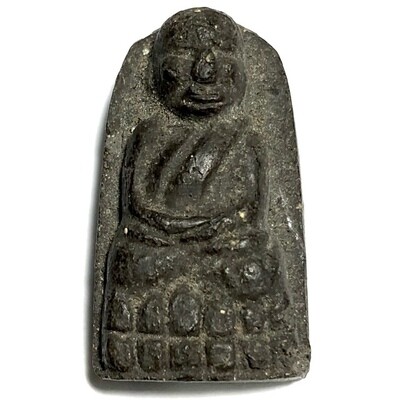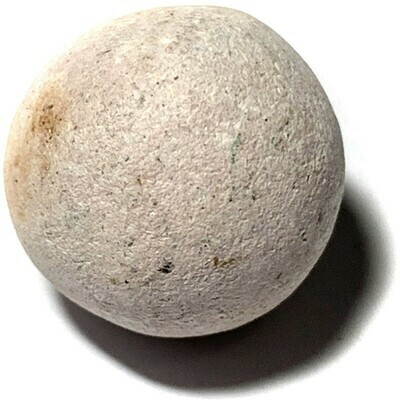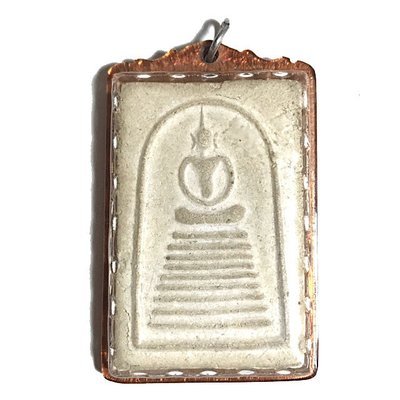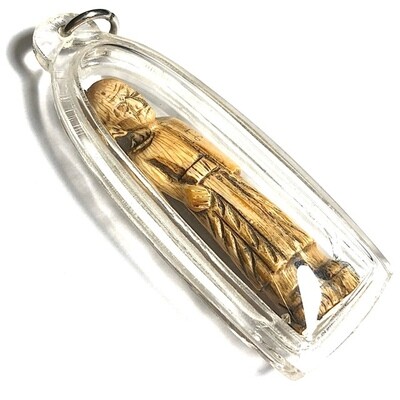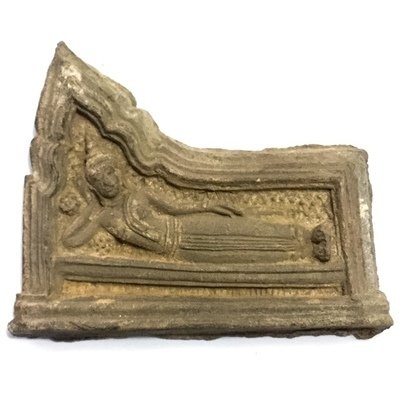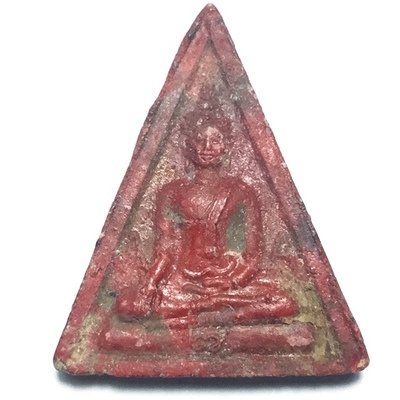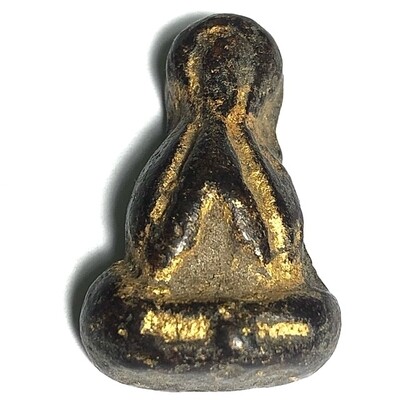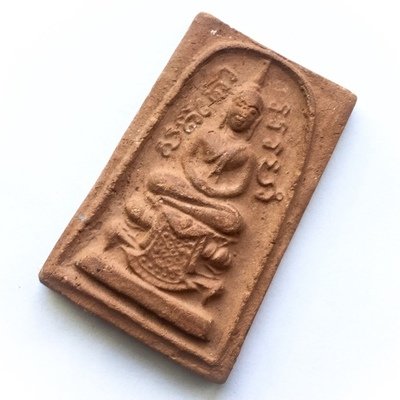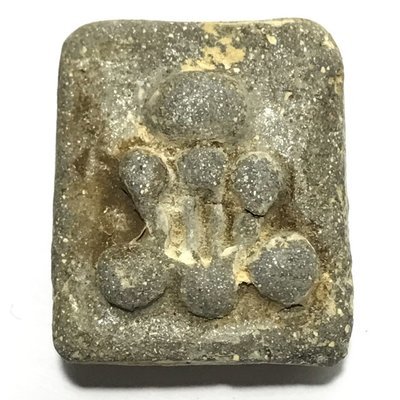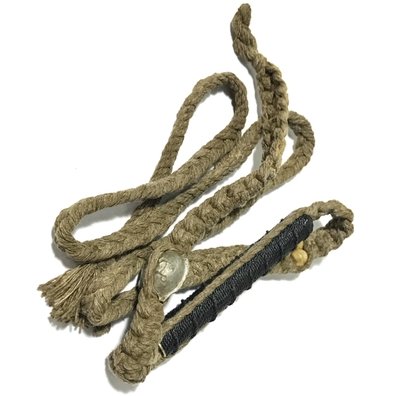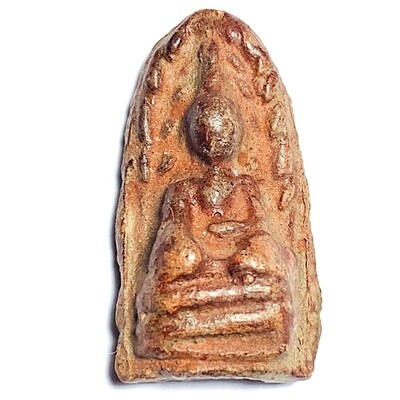A pristinely kept and extremely rare Rian Mangorn Koo Nuea Nava Loha Pim Pised Dtok Sorng Code Ma Wat Pha Nong Lom Run Sao Ha Maha Sethee 5th Lunar Saturday Blessing Ceremony Edition Guru Monk Coin, released in 2543 BE, to raise funds for the Kuti Songk Monks Huts and improve the facilities at the temple of Wat Pha Nong Lom.
This model of Rian Mangorn Koo twin dragons Monk Coin is a very rare Pim Pised (Niyom preferred) and differs from the majority of Rian Mangorn Koo Wat Pha Nong Lom Edition coins in Nava Loha, because of the double code MA stamp. Most coins of the Nava Loha series made for Wat Pha Nong Lom have only a single code Ma Stamp (on the Sangkati chest sash of the robe of Luang Phu), and only the Pim Pised special models received double code stamps. Only very few (unknown number) were distributed with double code stamp, making this not only a sacred, powerful master class amulet, but also a rare collectors piece.
The Rian Mangorn Koo of Luang Phu Hmun is, as are all of his amulets, known for the power of Jaroen Lap Wealth Increasement, and Lucky Fortunes, as well as for their Miraculous Protective Powers. Those born in the year of the dragon love to Bucha this amulet especially, for the obvious reason of the double dragon guardians.
For those with lower budgets, who seek power above collectability and rarity, we recommend to seek the Rian Mangorn Nuea Tong Daeng or Nava Loha single Code Ma, of the same edition, which carries a lower price than this special Nava Loha Pim Pised Gammagarn double code collectors edition model.
Palad Khik Nang Lorm, albino Mai Payung Sacred Treewood Circa 2460 BE Kroo Ba Nanta Wat Tung Man Dtai
One of a the very rare ancient amulets of this Great Lanna Master, the Palad Khik Nang Lorm, albino Mai Payung Sacred Treewood carving from Kroo Ba Nanta, hand inscribed with Khom Agkhara spells, with an ancient and exquisitely filigrain carved Palad Khik with the Nang Lorm Seductive Deva carved into the form of the Palad Khik Amulet, In rare white' Albino' Deva-Inhabited Sacred Payung Wood.
Hand carved by one of the preferred Master Looksit Artisans of the Guru, and empoweered with the Wicha Palad Khik Nang Lorm (also called, 'Nang Aen', meaning 'lady leaning overr for mating'), by Olden days Lanna Master Guru Monk Kroo Ba Nanta Nanto Bhikku, of Wat Tung Man Dtai, in Lampang. Kroo Ba Nanta was the Kroo Ba Ajarn of Kroo Ba Lerd, of Wat Tung Man Dtai.
The surface of the ancient treewood, and affixed gold leaf, reveals true ageing of a centenarian+ amulet, and the aging characteristics of the Palad Khik amulet the shout out the word 'ancient', as well as 'Kroo Ba Nanta'. The Nang Lorm Deva, is a type of Paetch Payatorn Palad Khik, and is a Deva, who likes to enjoy partaking of moods and desires, as its source of sustenance, and hence likes to cast spells to induce excitement and sexual moods in the hearts of humans. In this sence, the Palad Khik Nang Lorm can also be considered a Paetch Payatorn type Prai Deva.
Free Fed-Ex/DHL Express Shipping & offer of Free Solid Silver Custom Casing if Desired included with this amulet. The amulets of Kroo Ba Nanta are a very rare thing to come by, and are highly revered by Business Owners and those who are in High Administrative Positions, as well as those who seek to turn their fate around, and attract wealth, lovers, admirers and entourage, and receive merciful treatment from others.
The Thai Palad Khik an Animistic Phallic amulet, carved in the form of a Male sexual organ. Palad Khik are made in all sizes, ranging from miniature ones the size of your little finger, right up to ones which are higher than a human. Palad Khik are extremely popular with Thai people, worn as amulets tied to a cord around their waist. The belief in the Shiva Lingam, or ‘Leungk’ (Thai pronunciation) phallic energy of the Palad Khik, is derived from the Brahman influence which has been inflected on Thai Theravada Buddhism, since both belief systems came to Siam more than one or two thousand years ago. It is believed that the Palad Khik Lingam energy is the source of all life forms in the Universe.
This is the root of the act of reverence (Bucha/Poojah) to the Palad Khik as a Shiva Lingam, which honors Shiva as the Lord of the World. In India, not only is the Shiva Lingam worshiped, bit there exists also a cult which reveres the female sex organ, which is called the ‘Yoni’ (Vulva, female counterpart). The same thought is applied as that used too revere the Palad Khik Shiva Lingam, that is to say, that all created things must spring out of the Yoni instead of the Lingam.
The practice of making Palad Khik as a portable amulet, for ‘Bucha Siwalingk’ (praying to Shiva Lingam phallic Deity), entered Siam with the influence of the Khom race, whose language and alphabet the Thais absorbed and adapted into their own personalised fashion. Some have said that the integration of Pre-Buddhist beliefs and traditions, into the Thai Theravada Buddhist practice of the common Folk, such as worshiping amulets like the Palad Khik, is not in contradiction to the practice of Buddhism and presents no obstacles. In fact it is believed that since Buddhism sprang out of the roots of Brahman Cosmology, and that the people of Siam adopted Pre-Buddhist Brahman traditions and incorporated them, that this is even a benefit to the preservation of ancient knowledge, and of Thai history and tradition.
Most of these ceremonies do not come into any kind of dispute with Buddhist thought. In fact, Buddhist Thought bases itself on many concepts found in Hinduism, and in Thailand, the two Beleif Systems can hardly be separated. The word ‘Palad’, means ‘vice’ (as in ‘vice President, vice Mayor, etc). This has caused the Palad Khik to make some people t exclaim jokingly “why don’t you call it ‘Vice Mayor Khig’?. In fact, the word ‘Palad’ is derived from the Sanskrit ‘Bprasawa’, which translates as “he who stands by the side of’. This was adapted into the Thai language as Sanskrit and Buddhism entered and flourished in Siam. This is why in Thailand, an assistant to the Mayor (Nay Ampher), is called ‘Palad Ampher’.
But the real reason this word (Palad) is used for the Shiva Lingam amulet, is that it is worn as a companion to remain by the side of the wearer (‘he who stands by the side of’). Devotees of the Palad Khik tend to wear it outside of their clothes, around the neck, waist or sometimes hanging inside the trousers, against their loins. The word Palad Khik (“ปลัดขิก” -low sound) was originally pronounced ‘Palad Kik’ (“ปลัดคิก” – rising sound) in ancient times.
Many ancient Thai masters and amulet makers were inclined to making Palad Khik amulets, which were extremely popular with the Folk. Some had Khom Agkhara lettering, such as ‘U A Ma’ or ‘Om’, which are psalms to Brahma, Shiva and Vishnu. Some Ajarn would inscribe Sanskrit Agkhara instead, in Brahman tradition. Some of the most famous Gaeji Ajarn master monks who made Palad Khik amulets were; Hlwong Por Hluea, (Wat Saw Changoke), Luang Por Pina with his civet cat head carved Palad Khik, and Luang Por Ee (Wat Sattahib), Luang Por Soke, Kroo Ba Ajarn of the Wicha Palad Khik of Luang Por Fak, who in turn was Kroo Ba Ajarn in Wichja to the Great Luang Por Yid (Wat Nong Jork). Luang Por Kong of Wat Wang Sapparot with the Palad Khik Nang Aen, Luang Por Lang, and in more recent decades, the Great Luang Por Erp, of Wat Sum Gradtay. Even though today’s age of technology has brought many things to distract us from magic, the Palad Khik is still an extremely widespread belief and is worn by Thai people in all provinces.
Hang around any Samnak Sak Yant, or Samnak Ruesi for a while and you will most definitely see someone wearing a Palad Khik amulet. These days, The Palad Khik seems to have become extremely specialized and is made by various Ajarn, both ordained and lay masters. Each master makes a different Palad Khik with different purposes and uses. Be it good business, love affairs, or protections from evil, there seems to be a Palad Khik for every need. In the Isan country, Palad Khik is sometimes also called ‘Bak Ben’, or ‘Khun Phet’.
Palad Khik has been used by Isan people to ward off dark magic, for example in a case about 2548, the Folk of Roi Et were afraid of ‘Phii Mae Hmaay’ ( a female ghost who hunts men), so they erected a massive totem pole in the shape of a penis, with the initials (S and Y) of the man they believed to be the target of the ghost. They placed the giant Palad Khik in front of the mans house. Over the years, many rumours and legends of Palad Khik performing miracles of Kong Grapan Klaew Klaad magic and other protective spells, the popularity and demand for such talismanic charms increased, to the point where locals would flock to the various Gaeji Ajarn around the country who made these amulets. The Palad Khik was here to stay.
When the Gaeji Ajarn would make Palad Khik, they would have learned and researched the correct creation methods and ritual process to empower the amulets, in addition choosing auspicious and magical kinds of trees for the wood used to carve them out of. They would then inscribe sacred Khom Agkhara and make incantations of Kata to increase the magical charge and the strength of faith the devotee would have in such an amulet. The Palad Khik began to be used as a portable amulet through being carved from wood which was from the Cassiafistula Linn variety of tree, which has medicinal or healing properties.
Ancient Folk would then use this when traveling cross country; If they had to drink water from a stream, or other natural source which may have bacteria or dangerous amoebas, they would take the Palad Khik and use it to stir the water before drinking it, to remove any danger of illness. Palad Khik is not only applied for preventing dangers and illness, but is seen to possess all other kinds of magical properties, such as Metta Mahaniyom (preference and popularity, friendliness and love, compassion,receiving generosity and mercy), Choke Laap (luck and fortune), good salesmanship, Love charm, and the like.
Kroo Ba Nanta was one of the Greatest Lanna Masters in Living memory, before whose time, little is known of the names of the Masters who lived, so long ago was his Era, and perhaps the most difficult of the world famous Lanna Masters to study and collect, underllined by the fact that even Ajarn Spencer had to spend 10 years of study and document the whole life of KB Nanta in his Buddha Magic Series Ebooks, and study many exhibits before being able to seek and find these immensely rare and individual, inimitable Talismanic Lanna Sorcery Charms from thie Great and Elusive Lanna Tudong Master.
Because of this, and his constant absence on forest Tudong wandering,, it is not known when Kroo Ba Nanta began making Rahu Amulets, nor how many he made, except that old people who lived during his time, say that he had made them as long as they could remember. Many different shapes and forms can be found, but the trained eye can recognize his inscriptions, and the natural ageing process of the coconut shell, ivory, wood or sacred powders used to make the amulet.
The earliest actual evidence of his making the Rahu amulets was found inscribed on a Kala ta Diaw Rahu Image from Kroo ba Nanta with the year 2456 BE, which is considered to be one of his earlier one eyed coconut shell carvings.The amulet measures 5 x 4 Cm, and is made from one eyed albino coconut shell. Kroo Ba Nanta Nanto Bhikkhu was considered the older of the 2 Greatest Masters of the Wicha Pra Rahu of that particular Era, the other most famous Master being of course Luang Por Noi, of Wat Srisa Tong.
Kroo Ba Nanta was born in 2415 BE, and was indeed the older of these two Great Guru masters of Wicha, both of whom were famous for the Pra Rahu, and also the Wua Tanu Sacred Arrow Bull animist charm.Many people believe that Kroo ba Nanta was the Kroo Ba Ajarn of Luang Por Noi, but this is in fact a myth. Each of these Masters had their own personal Trajectories and their amulets differ in style and empowerment methods.
It would be more accurate to not compare the two, and to see that Kroo Ba Nanta and Luang Por Noi are equally Meritorious in their Mastery, and were perhaps the greatest Adepts of Wicha Pra Rahu in living memory.
Kroo Ba Nanta was an Upachaya Monk (entitled to ordain people as monks, which is one of the highest statuses), and was responsible for having built many important Buddhist Edifices in Lampang, Chiang Rai, Payao, and surrounding provinces, including Uposatha Shrine Rooms for temples, Chedi Stupas (22 in all), Kuti Huts, and 26 Vihara Shrines.
It is said that during the times of great difficulty of the Monk Kroo ba Srivichai, as Kroo ba Srivichai was placed under house arrest, that Kroo Ba Nanta made a Pra Rahu Kala Ta Diaw Amulet to pray to for the release of Kroo Ba Srivichai, and that he was released shortly after this. This event caused the amulets of Kroo Ba Nanta to become highly renowned for their Metta Maha Sanaeh Choke Lap, Serm Duang Magic.
In Thailand the Palad Mai Ga Fak Rak is popular with Market Stall Holders, and Shop Owners, who hang the Palad Khik in their place of Business, to attract and increase customers and sales. This amulet is useful as a seduction and wealth attraction charm, as well as for higher practitioners of Tantra and Vajrayana, kamasutra and similar forms of Occult practices.
Kata Jantra Bupaa (to be chanted in the night time)
Yadt-thadtang Ma Ma Dtangthaya Dtawadtang Mamadtang Wadtidtang Saegaa Ma Ma Gaasaegang Gaadtiyang Ma Ma Gaadtiyang Ma Ma Yadtigaa
When you begin to Bucha Rahu Deity, you should make the first ever session in the evening of a Wednesday (any time from 7 pm onwards). After you have done this once, you can make Bucha in the daytime if you wish, but the first time you must include the food offerings of black foods as well as the black incense. The second time onwards, only the incense is necessary in the daytime, if it is a lot of trouble to get the food offerings.
